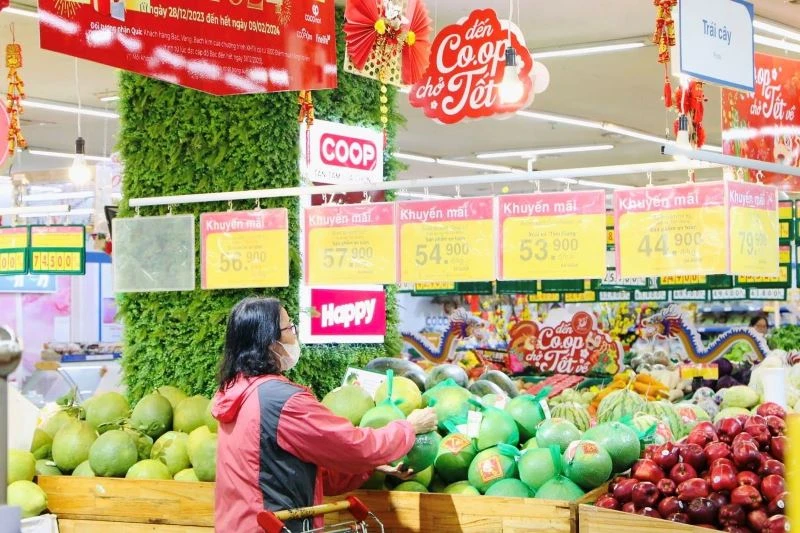Vietnamese distribution channels "support" Vietnamese agricultural products
From May to July every year is the time when agricultural products and fruits of the localities ripen. Many distribution channels, especially Vietnamese distribution channels, have stepped in to consume agricultural products, avoiding the situation of "good harvest, low price" right from the beginning of the season.
 |
Bring plums into the Saigon Coop system. |
Vietnamese distribution channel prioritizes Vietnamese agricultural products
On May 19, in Moc Chau district, Son La province, a ceremony was held to bring Son La plums into the distribution system of Saigon Co.op. Mr. Vo Tran Ngoc, Sales Director of Saigon Co.op , said that Saigon Co.op plans to consume 100 tons of Son La plums from Moc Chau and Yen Chau districts at the Co.opmart, Co.opXtra, Co.op Food, Finelife systems... in the 2024 crop. The products will have the best preferential prices on the market combined with product trial and display activities at 130 Co.opmart and Co.opXtra supermarkets.
“With the motto "Vietnamese supermarket, built by Vietnamese people, for Vietnamese people to serve", the proportion of Vietnamese goods in Saigon Co.op's distribution systems always reaches over 90%. We always support and are willing to cooperate with agricultural, industrial and handicraft production establishments to create opportunities to promote brands, expand markets and develop business", said Mr. Vo Tran Ngoc.
Not only with plums, Saigon Co.op's distribution system has actively participated in consuming Vietnamese agricultural products . With a widespread distribution system, over the years, Saigon Co.op has always supported and been ready to exchange and cooperate with production and business units, especially cooperatives and agricultural production units to support and help these units promote their images and brands to contribute to expanding the market. Vietnamese agricultural products are always given priority to be displayed in beautiful locations, especially during peak harvest time.
Saigon Co.op also signed contracts and memorandums of understanding with the Central Committee of the Vietnam Fatherland Front and the Vietnam Cooperative Alliance to bring good products to the market to serve customers. For producers and agricultural cooperatives, Saigon Co.op supports them in many ways, such as supporting and guiding them to complete documents and procedures to ensure that their documents are included in the system. At the same time, support is given to have the best and most beautiful display locations.
Along with Saigon Co.op, the BigGreen clean food system is also a pure Vietnamese distribution channel actively consuming Vietnamese goods. Mr. Nguyen Tien Hung, Director of BigGreen Vietnam Clean Food Company Limited, shared that BigGreen has currently opened 2 OCOP product introduction and sales points. The current rate of total OCOP products sold in the BigGreen system is about 60-65% with OCOP products connected and promoted for consumption being agricultural products, regional specialties such as Di Trach guava (Hoai Duc), Huynh Long melon (Vung Tau)... The rate of Vietnamese goods at BigGreen is up to approximately 100%.
Recently, at the conference connecting the consumption of early-ripening hybrid lychee in 2024 organized by the People's Committee of Hung Yen province, BigGreen signed with large cooperatives to meet consumer demand.
“With the advantage of early ripening and sweet quality, Phu Cu district’s hybrid lychee has high value and is sought after by many consumers. In the 2023 crop year, the company has signed a large order to consume Phu Cu early-ripening hybrid lychee and Hung Yen egg lychee, which are trusted and chosen by many customers,” Mr. Nguyen Tien Hung shared.
According to the Ministry of Industry and Trade, implementing the campaign "Vietnamese people prioritize using Vietnamese goods", in recent years, distribution channels have been involved in consuming Vietnamese goods, especially Vietnamese agricultural products when it comes to harvest season. Thanks to that, in recent years, the situation of "good harvest, low price" for agricultural products when entering the main season has significantly decreased. Currently, the proportion of Vietnamese agricultural products in distribution channels accounts for about 80%. For purely Vietnamese distribution channels such as Saigon Co.op, Tu Son supermarket, Hapro, Winmart... the proportion of Vietnamese goods is over 90%, especially Vietnamese agricultural products account for over 95%.
 |
At Winmart supermarket, the proportion of Vietnamese goods is up to approximately 95%. |
Recently, the Ministry of Industry and Trade has promoted the connection of supply and demand of Vietnamese products, including Vietnamese agricultural products, into the distribution system. For example, in 2023, the Ministry of Industry and Trade continuously connected typical OCOP products of Lang Son and Thai Binh to the Tu Son - An Giang supermarket system; connected Bac Kan agricultural products to the Saigon Co.op and BRG supermarket chains... After that connection chain, products such as dried star anise, Sli Que cake, star anise, incense, tea, gac vermicelli, black jelly, dong vermicelli... were signed to be distributed into distribution channels.
Untangling the bottlenecks of Vietnamese agricultural products
Although there have been many efforts to connect Vietnamese goods to distribution channels, according to experts, Vietnamese agricultural products still have many limitations.
Mr. Tran Hoang - Director of Co.opmart Victoria Hanoi Supermarket shared that the first limitation is the issue of goods source and output. The current market demand for specialty products and safe agricultural products is very high. However, whenever there is an increase in demand, these manufacturers are basically small-scale manufacturers, so sometimes the supply of goods is often broken or interrupted.
The second is the transportation problem. For cooperatives or producers in rural and mountainous areas, the process of transporting goods to delivery points, centers, and points of sale of the distribution system is still quite difficult because the transportation route is very long. Agricultural products need good storage conditions.
“For example, it may be okay for products with a long shelf life. However, for products such as leafy vegetables or fruits, they often ripen very quickly. By the time they reach the point of sale, many products are spoiled or the quality is no longer as fresh as it was at first,” Mr. Le Hoang shared.
Therefore, Mr. Le Hoang said that the State needs to have a master plan, for example, what to produce in this area, what crops to grow, what area and output to avoid surplus crises and having to go to the rescue.
Second, the distribution channel wants the State to support logistics, warehousing, and cold storage because agricultural products require quite high preservation conditions, while the main products of cooperatives are small-scale, and it is not possible to invest in refrigerated trucks, cold storage, and transportation systems. From there, bringing goods to supermarkets will ensure better quality.
Agreeing, agricultural expert Hoang Trong Thuy said that currently, there is a lack of preservation technology and cold storage, and a lack of wholesale markets, while technology is needed to ensure the quality of fruits and vegetables.
“When it comes to food, everyone wants it to be fresh, delicious, clean, and of consistent quality from the time it is picked until it reaches the dining table. Therefore, the State needs to support cooperatives and localities to invest in cold storage to maintain product quality when it is brought to supermarkets. Doing this will not only improve the competitiveness of the product but also improve the competitiveness of Vietnamese distribution channels compared to foreign distribution channels,” emphasized expert Hoang Trong Thuy.
Thuy Linh


